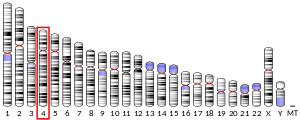Cathepsin O
Cathepsin O is an enzyme that in humans is encoded by the CTSO gene.[5][6]
Function
Cathepsin O is a cysteine protease and a member of the cathepsin family and papain superfamily. This proteolytic enzyme is involved in cellular protein degradation and turnover. The recombinant form of this enzyme was shown to degrade synthetic peptides typically used as substrates for cysteine proteinases and its proteolytic activity was abolished by an inhibitor of cysteine proteinase.[6]
gollark: join my Minecraft serverminecraft.osmarks.tk
gollark: Ah. It is “Ammonium“.
gollark: @Drucifer Ever used the realistic terrain generation MC mod?
gollark: I got 161 levels overnight from that then lost them somehow.
gollark: No.
References
- ENSG00000256043 GRCh38: Ensembl release 89: ENSG00000263238, ENSG00000256043 - Ensembl, May 2017
- GRCm38: Ensembl release 89: ENSMUSG00000028015 - Ensembl, May 2017
- "Human PubMed Reference:". National Center for Biotechnology Information, U.S. National Library of Medicine.
- "Mouse PubMed Reference:". National Center for Biotechnology Information, U.S. National Library of Medicine.
- Santamaría I, Pendás AM, Velasco G, López-Otín C (October 1998). "Genomic structure and chromosomal localization of the human cathepsin O gene (CTSO)". Genomics. 53 (2): 231–4. doi:10.1006/geno.1997.5180. PMID 9790772.
- "Entrez Gene: cathepsin O".
Further reading
- Shi GP, Chapman HA, Bhairi SM, et al. (1995). "Molecular cloning of human cathepsin O, a novel endoproteinase and homologue of rabbit OC2" (PDF). FEBS Lett. 357 (2): 129–34. doi:10.1016/0014-5793(94)01349-6. PMID 7805878.
- Strausberg RL, Feingold EA, Grouse LH, et al. (2002). "Generation and initial analysis of more than 15,000 full-length human and mouse cDNA sequences". Proc. Natl. Acad. Sci. U.S.A. 99 (26): 16899–903. doi:10.1073/pnas.242603899. PMC 139241. PMID 12477932.
- Velasco G, Ferrando AA, Puente XS, et al. (1994). "Human cathepsin O. Molecular cloning from a breast carcinoma, production of the active enzyme in Escherichia coli, and expression analysis in human tissues". J. Biol. Chem. 269 (43): 27136–42. PMID 7929457.
- Gerhard DS, Wagner L, Feingold EA, et al. (2004). "The Status, Quality, and Expansion of the NIH Full-Length cDNA Project: The Mammalian Gene Collection (MGC)". Genome Res. 14 (10B): 2121–7. doi:10.1101/gr.2596504. PMC 528928. PMID 15489334.
- Barbe L, Lundberg E, Oksvold P, et al. (2008). "Toward a confocal subcellular atlas of the human proteome". Mol. Cell. Proteomics. 7 (3): 499–508. doi:10.1074/mcp.M700325-MCP200. PMID 18029348.
External links
This article incorporates text from the United States National Library of Medicine, which is in the public domain.
This article is issued from Wikipedia. The text is licensed under Creative Commons - Attribution - Sharealike. Additional terms may apply for the media files.



